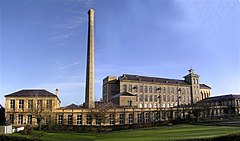Sion Mills
Sion Mills
|
|
|---|---|
 Herdman's Mill |
|
| Sion Mills shown within Northern Ireland | |
| Population | 2,050 (2001) |
| Irish grid reference | H339932 |
| • Belfast | 84 mi (135 km) |
| District | |
| County | |
| Country | Northern Ireland |
| Sovereign state | United Kingdom |
| Post town | STRABANE |
| Postcode district | BT82 |
| Dialling code | 028, +44 28 |
| EU Parliament | Northern Ireland |
| UK Parliament | |
Sion Mills is a village to the south of Strabane in County Tyrone, Northern Ireland, on the River Mourne. In the 2001 Census it had a population of 2,050 people. It is a tree-lined industrial village and designated conservation area, particularly rich in architectural heritage.
The village of Sion Mills was established by the Herdman family in 1835. The family operated a linen production mill in the village.
The name Sion comes from the townland of Seein, which lies to the south of the village. It is an anglicisation of an Irish placename: either Suidhe Fhinn (meaning "seat of Finn") or Sidheán (also spelt Síodhán and Sián, meaning "fairy mound"). The second part of the name is the English "mill".
Sion Mills was laid out as a model linen village by the Herdman brothers, James, John and George. In 1835 they converted an old flour mill on the River Mourne into a flax spinning mill, and erected a bigger mill behind it in the 1850s. However, nearly everything in Sion Mills today was designed later, in the 1880s and 1890s, by James Herdman's son-in-law, the English architect William Frederick Unsworth. Sion House, a half timbered Elizabethan style mansion originally built in the early 1840s, was largely remodelled and expanded in the 1880s by Unsworth, around the same time as he was designing the first Shakespeare Memorial Theatre in Stratford-upon-Avon (this theatre was destroyed by a fire in 1926). More modest half timbered buildings include the gatehouse, the Recreation Hall and Old St. Saviour's Church. Unsworth based his design for the polychrome Anglican church, the Church of the Good Shepherd (1909), on a church in Pistoia in Tuscany. This church is built in an Italian neo-Romanesque style. By contrast, the modern Church of St Teresa (1963, by Patrick Haughey), the Catholic place of worship, is admirable for its severely plain lines – a long rectangle with a striking representation of the Last Supper on the slate facade. Oisín Kelly was the artist.
...
Wikipedia

